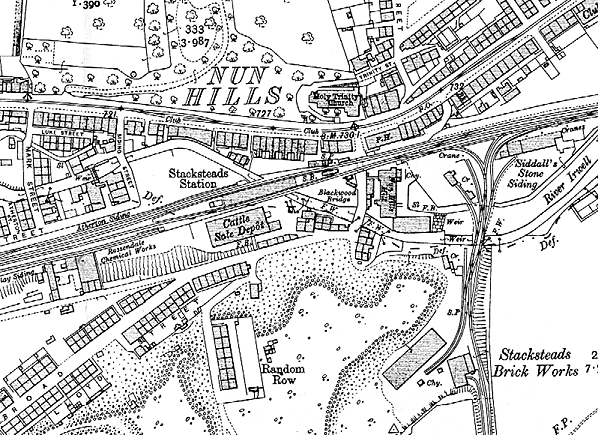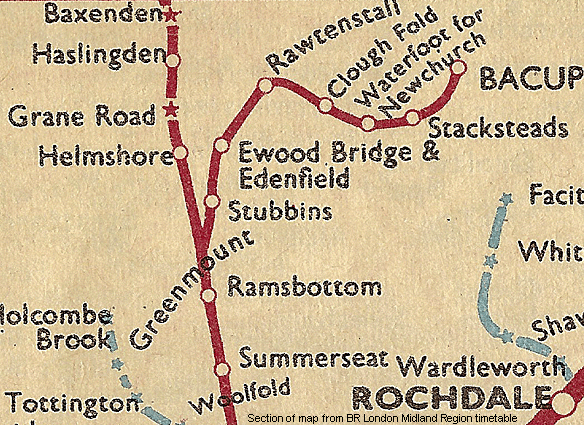Stackstead station is located in the Rossendale valley. Rossendale is a deep, narrow valley in the Lancashire Pennines. Encouraged by the construction of the Haslingden to Bacup turnpike road in 1826-8 the five miles between Bacup and Rawtenstall, along the headwaters of the River Irwell, became packed with terraced housing and mills, wherever the valley was wide enough or the slopes gentle enough to accommodate them. Because of the west-to-east alignment and steep slopes, the valley floor of Rossendale is permanently in shadow in late autumn and winter, and this is particularly noticeable in the gorge at Thrutch, where there was simply no space for housing and industry. As elsewhere in the Lancashire Pennines, textile mills lined the swift-flowing river, but Rossendale developed a curious industrial economy with woollen as well as cotton mills, and a particular speciality in manufacturing felt and (from the 1870s) carpet slippers.
Centred at Waterfoot and Newchurch the slipper industry was an offshoot of wool and felt manufacture, and of the custom of millworkers to wrap waste felt around their clogs. To this day the footwear outlets in Rossendale are reminders of slipper manufacture which, like so much of the Lancashire textile industry, has largely moved to overseas where labour is cheaper. In the 1840s the expanding industry and population of Rossendale promised to reward any railway company that could serve this valley, and once a railway had reached Bacup it enabled the local economy to prosper well into the 20th century.
Stacksteads station opened on 1st October 1852 when the final extension of the line to Bacup was complete. The line was single-track so the station was provided with only one platform west of the Stacksteads to Blackwood road level crossing.
Train services operated to Bacup and to Manchester via Clifton Junction. The line proved popular, and passenger numbers built up rapidly.
 |
On 13th May 1859 the Lancashire & Yorkshire Railway (LYR) absorbed the ELR, and by the 1870s traffic levels had reached such a level that the LYR decided to double the line between Rawtenstall and Bacup. Authorisation for the works was given on 24th July 1876. In addition to formidable obstacles to the works requiring large scale engineering tasks - such as |
the creation of a new parallel tunnel at Newchurch - Stacksteads station could not accommodate two lines and had to be completely rebuilt.
| An island platform was constructed further west of the original platform; the site was unusual in that it straddled a bridge over the River Irwell. The station’s facilities were located on the island platform. They consisted of a wooden single-storey building which contained a booking office, staff accommodation, waiting facilities and toilets. The building had canopies |
 |
to protect passengers from the elements. Access to the station was by two covered stairways on the west side of the Stacksteads to Blackwood Road, one on the north side of the line and the other on the south. These led down to a subway which passed beneath the line and linked into a further covered stairway which led up between the two tracks to the island platform at its eastern end. The arrangement meant that passengers could access the station without having to cross the line. Pedestrians could also pass beneath the line when the crossing gates were closed to road traffic.
 |
The new station facilities at Stacksteads opened on 23rd July 1880. However full double-track working on the line did not start until17th March 1881. On this date a signal box bearing the station’s name opened at Stacksteads, south of the line, and west of the level crossing.
The station had basic goods facilities but didn't handle livestock. There were private sidings on both side of the line to the west of the station, that on the down side was latterly known as Stacksteads Coal Siding. To the east of the station, a short branch ran south to the Stacksteads Brick Works and Frost Holes Quarry with Siddalls Stone siding located at the junction. The quarry line and stone siding had gone by 1930.
From 1st September 1879 Stacksteads’ passenger services to and from Manchester were transferred south of Bury from the route via Clifton Junction to a new line via Prestwich.
In 1914 the LYR introduced a ‘Rail-motor’ service – known affectionately as ‘Little Billie’ - between Ramsbottom and Bacup; this called at all stations, including Stacksteads, and supplemented trains that ran through to Manchester. From 11th April 1916 through passenger services to Manchester were diverted once more, this time to travel via Heywood, adding a considerable mileage to their journeys. The reason for the change was that from this date electric services began on the Bury to Manchester (via Prestwich) line.
|
Passengers for Manchester from Stacksteads were encouraged to change onto the electric trains at Bury for a quicker onward journey, and most of them did so. Within a few years many southbound services terminated at Bury Bolton Street.
 |
On 1st January 1922 Stacksteads became part of the London & North Western Railway (LNWR) when that company absorbed the LYR. However only one year later, on 1st January 1923, the LNWR became part of the London Midland & Scottish Railway (LMS). By summer 1932 the station had thirty services travelling northbound to Bacup on weekdays. The first service |
which had originated from Ramsbottom left at 6:33 am. The last service which had originated from Bury Bolton Street left Stacksteads for Bacup at 11:52 pm. Of the thirty services most trains had started from Bury Bolton Street or from Manchester Victoria., but one train had commenced its journey from Bury Knowsley Street and one from Bolton. Some services had started from Ramsbottom and two trains started from Rawtenstall. On Tuesday and Fridays only there was an additional service to Bacup at 5:44 pm which originated at Ramsbottom.
| In the southbound direction there were twenty-eight weekday departures, the first being for Middleton Junction at 05:23 am. The last train was for Bury Bolton Street and it left Stacksteads at 10:15pm. The rest of the services tended to travel either to Bury Bolton Street or Manchester Victoria, but there were trains at 09:03am, 10:23am and 2:58pm which went |
 |
to Bury Knowsley Street, as well as shorter workings to Ramsbottom. There were also two services from Stacksteads that terminated at Rawtenstall.
Stacksteads had never handled much goods traffic and its goods service was withdrawn from 1st December 1947. On 1st January 1948 Stacksteads became part of the nationalised British Railways (London Midland Region). In 1954 the line between Bury and Bacup was considered busy enough to warrant the introduction of modern rolling stock, and it was reported in the local press that new diesel multiple units (DMUs) were to be introduced; they entered service on the line in February 1956. Stacksteads had thirty-five trains in each direction, giving a half-hourly service: the most intensive that the line would see.
 |
The purpose of The Reshaping of British Railways (Beeching Report) of March 1963 was to create an economically viable network, involving the closure of many loss-making passenger lines and stations. The report’s proposals for Lancashire and north Manchester were astonishing. The entire route from Manchester via Bury Bolton Street to Bacup and |
Accrington was earmarked for closure, yet the nearby Manchester – Oldham – Rochdale and the Bolton – Bury Knowsley Street – Rochdale lines were not. The absurdity of withdrawing passenger services on the heavily used, electrified service between Manchester and Bury was acknowledged when, on 8th February 1965, the Minister of Transport refused consent to closure. However on 14th September 1966 the Minister gave permission for the Rawtenstall to Bacup and Bury to Accrington lines to close, which they did on 5th December 1966. The final passenger train left Stacksteads on Saturday 3rd December 1966; the signal box also closed in that month. Goods services continued to pass through Stacksteads for a short period up to 1968, after which the line closed completely. By February 1969 the tracks through the station had been lifted.
In 1976 all that remained at Stacksteads was the island platform. In August 2010 buildings were being erected on the track-bed west of Blackwood Road, but a section of glazed brick wall from the access steps on the north side of the line could still be seen.
Tickets from Michael Stewart , route map drawn by Alan Young
Other web sites: www.bacuptimes.co.uk, includes further history and pictures of the Bacup line.
Click here to see of film of a train journey between Bury and Bacup in 1966
See also the Ramsbottom Model Railway Club web site which features 106 old photographs of the East Lancashire Railway and photographs of the clubs excellent layout of Ramsbottom & Stubbins.
Sources:
To see other stations on the East Lancashire Railway Clifton Junction - Bacup line click on the station name on the station name: Clifton Junction, Molyneux Brow, Ringley Road, Radcliffe Bridge, Withens Lane, Bury Bolton Street, Summerseat, Ramsbottom, Stubbins, Irwell Vale (new station on the ELR), Ewood Bridge & Edenfield, Rawtenstall, Clough Fold, Waterfoot for Newchurch & Bacup
See also Stubbins Junction to Accrington:
Helmshore, Haslingden, Baxenden & Accrington |

old2.jpg)


old4.jpg)
old1.jpg)
old3.jpg)
6.jpg)
2.jpg)
3.jpg)








1.jpg)
old_thumbs5.jpg)
thumb4.jpg)
thumb5.jpg)

 Home Page
Home Page